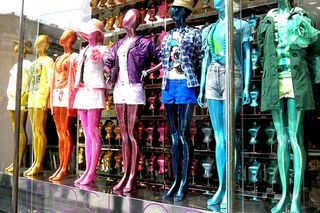
Manufacturing New Clothes Will Always Harm the Environment
An organic cotton t-shirt might be as damaging as fast fashion.

By 2030, India is projected to be the third-largest apparel market in the world. It’s already among the world’s largest fashion producers, along with nearby Bangladesh and Sri Lanka. As Indian consumers are on the cusp of more than doubling their spending on clothes within the next decade, it’s worth checking in on the environmental impact of our outlay on fast fashion — and whether the industry’s touted routes to sustainability will actually offset its increasing harm.
The effects of fast fashion
By its nature, fast fashion prioritizes speed and low costs to deliver new trends every few weeks. Which means, of course, that the process of production, manufacture, and disposal are particularly bad for the environment. As multinational fashion brands like H&M, Forever 21, and Zara rush to bring the latest styles off the catwalk and into production, there’s an enormous amount of pressure to cut corners, despite the cost to the environment. And with the popularity of online retailers in India like Jabong and Myntra, fast fashion is literally at our fingertips.
Consumer trends clearly reflect this embrace of quick, disposable clothes. In the past 15 years, the production of clothes has almost doubled, and clothes’ shelf life has decreased by a third. And where do these clothes go? Every second, an equivalent of one garbage truck of textiles is landfilled or burned, according to a report from the Ellen MacArthur Foundation, a charity funding research and implementation of sustainable policies.
But the environmental cost of this pace of production doesn’t start with waste disposal; it starts with the process of producing raw materials and manufacturing. Bright colors and prints are only possible by dyeing the fabric with toxic chemicals, which means that the water supply in countries like India, Bangladesh, and Sri Lanka, where most fast fashion manufacturing takes place, is polluted. In fact, textile dyeing is now the second-largest polluter of clean water globally.
Related on The Swaddle:
Talking Feminism and Fashion with ‘Mannequin’ Author Manjima Bhattacharjya
Polyester, a favorite material for fast fashion since it’s cheaper and faster to produce than natural fibers like cotton, is particularly harmful. Every time polyester is washed in washing machines, it sheds microfibers that add to the level of plastic in the oceans. A 2017 report from the International Union For Conservation of Nature showed that 35 percent of all microplastics in the ocean comes from the washing of synthetic textiles. Local sewage treatment plants aren’t able to stop them from polluting water bodies, and since they don’t biodegrade, aquatic life like plankton ingest them. The amount of ingested microfibers accumulates the higher up the food chain you go, toward humans and larger mammals — for whom these fibers are carcinogenic.
Ethical brands also have downsides
Many people have turned to ethically conscious brands that promise textiles produced from organically grown, all-natural fibers. But these brands’ processes might also negatively impact the environment. For example, organic cotton from non-GMO seeds requires more land and more water to produce the same amount of cotton grown without organic certification. It takes almost 2,000 liters of water to produce enough cotton for a t-shirt, but almost 2,500 liters for an organic cotton t-shirt, according to Cotton Inc.
The process of creating a garment also doesn’t just stop at how fibers are grown and harvested; they still need to be spun or woven, dyed, finished, sewn, and transported. Although organic cotton might be better for the environment than polyester, since it doesn’t shed plastic microfibers, the impact of dyeing it is far worse than the dyeing of polyester. So, although fast fashion is incredibly damaging to the environment, eco-friendly, organic alternatives have their own disadvantages.
It seems that we are, as consumers, stuck between a rock and a hard place. The decisions of what clothes to buy, and from which brands, each have their own downsides. Though some are a lot worse for the environment than others, in the end, all manufacturing takes a toll on our already imbalanced ecosystem.
What can we do as consumers?
Instead of relying on eco-friendly methods of manufacturing, most activists point to the need for a more circular model of textile production that reuses materials wherever possible. Recycled or upcycled — that is, creatively repurposed from used materials — textiles make a huge difference to the environment. On average, a person keeps an item of clothing for three years before throwing it away; only 15 percent is donated or recycled at that time. If that piece is kept for nine months more, the impact of manufacturing new clothes as replacements would be dramatically reduced: Related carbon dioxide emissions would decrease by more than one-fourth; water use, by one-third; and waste, by more than one-fifth. Hand-me-downs and donating clothes could help extend the Earth’s lifetime — and honestly, vintage always looks good.
In addition, keeping an eye on how you maintain the clothes you already own is useful; environmentally friendly laundry habits like washing in cold water, drying clothes on a line, and using biodegradable detergents are all ways to maintain sustainability.
Related on The Swaddle:
Climate Change Is Driving Childhood Obesity, Undernourishment by Making Healthy Food Less Accessible
Although sustainable brands are making some headway, the fashion industry needs to incorporate eco-friendly solutions on a much wider scale — thinking about every step of a piece of clothes’ journey, from the production of fibers, to the item’s eventual disposal. Programs like Cradle to Cradle are beginning the process of ensuring this overhaul takes place. To achieve Cradle to Cradle certification, companies’ products are evaluated and optimized for their recyclability or biodegradability, human and environmental health impact, carbon management, renewable energy use, water use, and social fairness to the community. In 2017, two Indian companies — Pratibha Syntex and Cotton Blossom — were awarded Cradle to Cradle certification. The brands priced their clothing at approximately Rs. 550-650, and its products can be composted at home, decomposing in fewer than 12 weeks.
We still have a long way to go for the manufacturing of clothes to cause the least amount of harm to the planet. As the fashion industry works towards an overhaul, consumers can start educating themselves to reduce impact on their own. From buying less clothes, keeping and mending them to last longer, ensuring sustainable laundry regimens, and responsibly donating or disposing of items, a little effort can definitely go a long way.
Nadia Nooreyezdan is The Swaddle's culture editor. Since graduating from Columbia Journalism School, she spends her time thinking about aliens, cyborgs, and social justice sci-fi. She's also working on a memoir about her family's journey from Iran to India.
Related


Facebook Knowingly Tricked Kids Into Spending Money on Online Games
